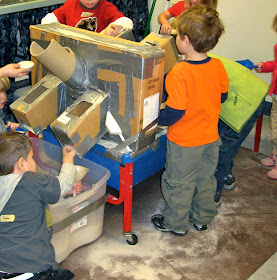Here is an attempt to show the flow of play in and around the dividers.
Note that there are no limits on the number of children at the table; they do a nice job of limiting themselves and negotiating spaces.

For the dividers, the initial rush usually finds children working in their own little spaces. Before long, though, children start interacting between the spaces, sometimes oblivious to who is in the other space, but often times creating some type of social interaction/game. This happens quite naturally without any prompting.
Children drift off to other activities in the room. Some children who have not had a chance, or do not like crowds, take their turn at the sensory table. Sometimes that play is solitary.
After checking out other activities room, some children come back and take play in a different direction, often on a more complex level.
Here, Charlie has come back to the table. He has given himself the task of putting all the pellets in one of the square foot sections of the divided table. Notice he has already emptied the adjoining section and has moved over to the end space on the same side. He now transports the pellets from one end of the table to the other. Miles joins him. Miles does not use words to join Charlie's play. Instead he uses non-verbals to insert himself into the play. Charlie accepts his overtures and now turns the play into more than just filling the space with pellets; it also becomes burying Miles' hands.
David is in another part of the room by himself. No one is at the table at this point, so I invite him over to see the pellets and the divider. See his play in a previous post
here.
Next comes Maggie. She watched David pour through the window. Now it is her turn. She does it a little bit differently. She scoops pellets into a juice container, puts it through the same window, and then dumps it out.
Minutes later, David is back operating in the space where Charlie has amassed the pellets.
David pours the pellets into the pail next to the table. I say: "I heard that." He smiles and does it again. Maggie hears David pour the pellets into the bucket. To her, though, it sounds like David has poured them onto the floor. She cannot see David because she is on the other side of the divider. She pours pellets onto the floor and looks to me for validation. She is expecting me to say the same thing I said to David. She was surprised when I told her not to pour the pellets on the floor. I explained that David was pouring into the bucket and not onto the floor. She scooped up some pellets, walked around the divider and poured some pellets into the same bucket. Now I could tell her: " I heard that." She was validated and quite happy with herself. This also moved her to the other side of the table.
Charlie hears the pellets falling in the pail and comes over and says: "Oh, we're moving it into the bucket, now!"
Charlie pours pellets into the bucket and Miles follows suit. Charlie tries to find a place to scoop pellets. He gently inserts himself between Maggie and Miles. Miles wants to get some more pellets so he gives Charlie a little hip. Charlie says "Hey!" and Miles responds with a "Hey" back. They work it out so both are scooping and dumping pellets. In the meantime, Maggie is scooping pellets from the same small space and David is reaching into that space through the window getting his hand caught in the window. He then comes around to check out where his hand got stuck.
What is striking and amazing is that the children went from individual play in each space, to social interaction between the dividers, to more individual play---some of which shows elements of awareness of the other's play---to four children all operating in a small section of the table no larger than one square foot. The flow of this play took place in the course of about 40 minutes.
Set up an apparatus, let them go, offer a few prompts, and the natural flow of play is a wonder to behold.
























